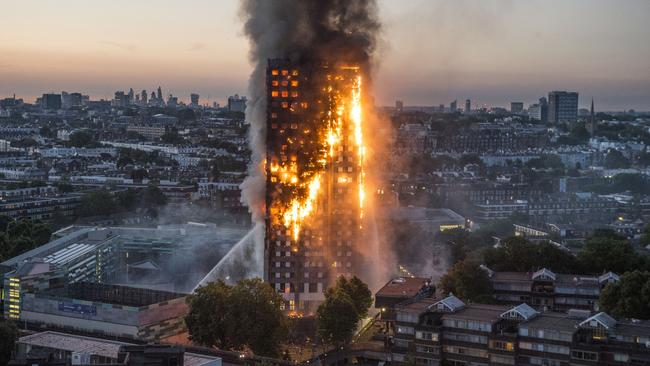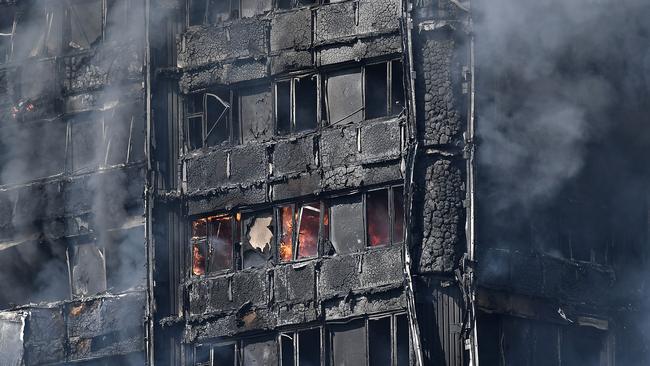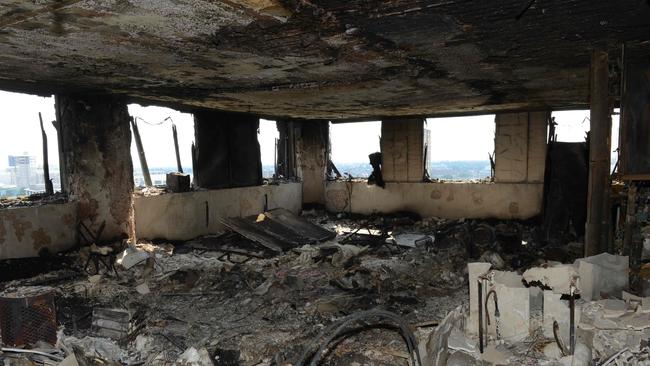Failures led to Grenfell’s ‘path of disaster’
An extensive 1700-page report into the tragedy which claimed 72 lives has delivered scathing reviews of the cladding and insulation companies that fitted the doomed building.

You can now listen to The Australian's articles. Give us your feedback.
Seven years after the Grenfell Tower blaze in London that killed 72 people, including two Australians, an inquiry has highlighted a chain of failures that led to the disaster and laid the heaviest blame on dishonest cladding companies.
Families have demanded manslaughter charges be laid against those responsible but criminal charges may not come for a further two years.
Prosecutions are unlikely to start before 2027, the Metropolitan Police said.
As many as 19 organisations and 58 individuals are under investigation over the fire, which began in the kitchen of a fourth-floor flat of the 23-storey building in the early hours of June 14, 2017.
In an extensive 1700-page report after six years of hearings, inquiry chair Martin Moore-Bick was scathing of Arconic, the company that made the cladding panels, for deliberately concealing the safety risk while other companies that produced the insulation, Celotex and Kingspan, were also accused of misleading conduct.
“All of the deaths were avoidable,” Sir Martin said.
He said the cladding was “by far the largest contributor” to the fire and companies had deliberate and sustained strategies to make their products appear safe. He also found other companies such as architects, including Studio E and Harley Facades were incompetent and held significant responsibility for the fire.
The report says there were many opportunities missed by successive governments to address the risks of the flammable cladding. It was also withering about the council, Royal Borough of Kensington and Chelsea, and its Tenant Management Organisation, saying they had a “persistent indifference to fire safety, particularly the safety of vulnerable people”.
The fire quickly took hold and spread throughout the high-rise building because of extensive non-fire rated cladding which had been used on the outside of the building in a refurbishment to save costs.

The combustible cladding was made from plastic and aluminium and installed for insulation and to improve the outside appearance. The inquiry heard of “buck passing” about responsibility for the use of the cladding, from the Kensington and Chelsea council, the council’s tenant management, to various architects, contractors and building experts and cladding suppliers.
An earlier report had heavily criticised the fire brigades “stay put” policy where residents were told to stay inside their flats rather than seek to escape. That policy was reversed only when it was too late, several hours after the fire had begun to raze the building.
Australians Victoria King and her daughter, Alexandra Atala, were killed inside their 20th-floor flat. King had celebrated her 71st birthday just two days before.
Their family said in a statement after the fire that King and Atala, 40, were “devoted to one another”, adding that “some comfort can come from the knowledge that she (King) and Alexandra … spent so many mutually supportive years together.
“They died at each other’s side and now they can rest together in peace.”

Being on one of the upper floors was a death trap. King and Atala’s neighbours on the same floor suffered the same horror: artist Khadija Saye, 24, her mother, Mary Mendy, and a 12-year-old schoolgirl, Jessica Urbano Ramirez, were all killed. So, too, was neighbour Farah Hamdan, 31, who was holding her six-month-old baby, Leena Belkadi, alongside her husband, Omar, 32. Another daughter, Malak Belkadi, 8, died in hospital.
Some of the residents on the upper floors tried to get higher in a misguided belief fire crews could rescue them by helicopter. Some had earlier been told the flats would provide protection from the fire for several hours and it was safest to stay inside and not seek to use the fire escape.
The resident in the fourth floor flat had been woken by a smoke alarm and immediately called the fire brigade at 00.54 with the first fire crews entering at 01.07 hours and entering the kitchen at 01.14.
At that time the fire had already taken hold of the outside cladding. The rapid spread of the fire was extraordinary and fire crews struggled to prioritise rescues and lacked an understanding of the behaviour of such a fire, the inquiry found. From the fourth floor, the fire spread rapidly upwards and across the eastern side of the building and it reached the top floor at 01.26 hours. It then spread around the northern face 16 minutes later.




To join the conversation, please log in. Don't have an account? Register
Join the conversation, you are commenting as Logout